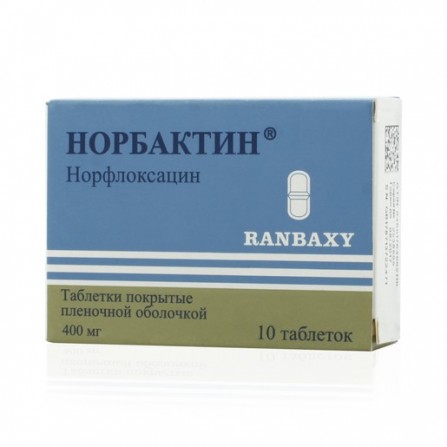Norbactin pills coated 400mg N10
Condition: New product
990 Items
Rating:
Be the first to write a review!

More info
Active ingredients
Norfloxacin
Release form
Pills
Composition
1 tablet contains: Active substance: norfloxacin 400 mg Excipients: MCC, croscarmellose sodium, sodium lauryl sulfate, corn starch, colloidal silicon dioxide, magnesium stearate, purified talcum sheath: hypromellose, macrogol 400, purified talcum, titanium dioxide, myopia, myopia, purified talcum, myopia; lost in the production process)
Pharmacological effect
Antimicrobial synthetic agent of the fluoroquinolone group of broad-spectrum. It has a bactericidal effect. Suppressing DNA gyrase violates the process of DNA supercoiling. Highly active against most gram-negative bacteria: Escherichia coli, Salmonella spp., Shigella spp., Proteus spp., Morganella morganii, Klebsiella spp. (including Klebsiella pneumoniae), Enterobacter spp., Serratia spp., Citrobacter spp., Yersinia spp., Providencia spp., Haemophilus influenzae, Pseudomonas aeruginosa, Neisseria gonorrhoeae, Neisseria meningitidis. It is active against some gram-positive bacteria (including Staphylococcus aureus). Anaerobic bacteria are resistant to norfloxacin, insensitive to Enterococcus spp. and Acinetobacter spp. Resistant to β-lactamase.
Pharmacokinetics
When ingestion is absorbed about 30-40%, food intake reduces the rate of absorption. Binding to plasma proteins is 14%. Norfloxacin is well distributed in the tissues of the urogenital system. It penetrates the placental barrier. About 30% is excreted in the urine unchanged.
Indications
The drug is used to treat patients suffering from infectious diseases caused by microorganisms susceptible to the action of norfloxacin, including: Infectious diseases of the urinary system organs. Infectious diseases of the gastrointestinal tract. The drug is also used to treat patients with uncomplicated gonococcal infection. The drug can be assigned to prevent travelers' diarrhea.
Contraindications
Contraindicated in patients with anamnestic indications of hypersensitivity to norfloxacin or any other chemical analogue. It should not be used in patients with severe renal insufficiency (creatinine clearance less than 10 ml / min / 1.73 m2) and pregnant women.
Precautionary measures
On the part of the digestive system: nausea, heartburn, anorexia, diarrhea, abdominal pain. From the side of the central nervous system: headache, dizziness, fatigue, sleep disorders, irritability, anxiety. On the side of the urinary system: interstitial nephritis.
Use during pregnancy and lactation
Norfloxacin is contraindicated during pregnancy and lactation (breastfeeding), because in experimental studies it was found that it causes arthropathy.
Dosage and administration
Acute urinary tract infections - 400 mg twice a day for 7-10 days. Acute uncomplicated cystitis - 400 mg twice a day for 3 days. Recurrent or chronic infections of the urinary tract with exacerbations - 400 mg twice a day for 4 weeks, then, if necessary, 400 mg per day for up to 12 weeks. There is evidence of a significant reduction in the frequency of recurrence of urinary tract infections in women with frequent recurrent infections with prophylactic administration of 200 mg of Norbactin once after intercourse. Chemoprophylaxis for urological interventions, operations and for postoperative infections - 400 mg twice a day before and after surgery, as needed. Acute uncomplicated gonococcal infections - 800 mg once. Bacterial intestinal infections - 400 mg twice a day for 5 days. Prevention of travelers' diarrhea - 400 mg once a day (no more than 21 days). The widespread use of antibacterial drugs for the prevention of diarrhea is not recommended, they can be used in high-risk areas, in the presence of aggravating factors (hypochlorhydria, the use of antacids and secretion inhibitors, dysgammaglobulinemia) and a high risk of complications due to dehydration in somatic diseases, diuretic, cardiac glycosides. For better efficacy and tolerability, Norbactin should be taken one hour before or two hours after a meal. It can not be taken with antacids. Patients are advised to drink enough liquid to prevent crystalluria.
Side effects
From the digestive system anorexia, bitter mouth, nausea, vomiting, abdominal pain, diarrhea, pseudomembranous enterocolitis (with prolonged use), elevated liver transaminaz.So crystalluria the urinary system, glomerulonephritis, dysuria, polyuria, albuminuria, urethral bleeding, hypercreatininemia . On the side of the nervous system, headache, dizziness, insomnia, hallucinations. On the part of the cardiovascular system, tachycardia, arrhythmias, lowering blood pressure, fainting,vasculitis. Allergic reactions, pruritus, urticaria, edema, Stevens-Johnson syndrome. On the part of the musculoskeletal system, arthralgia, tendinitis, tendon ruptures. On the part of the blood-forming organs, hematocrit.
Interaction with other drugs
With simultaneous use of norfloxacin with warfarin increases the anticoagulant effect of the latter. With simultaneous use of cyclosporine norfloxacin, an increase in the concentration of the latter in the blood plasma is observed. While taking Norfloxacin and antacid agents or drugs containing iron, zinc, magnesium, calcium or sucralfate, absorption of norfloxacin is reduced due to the formation of complexones with metal ions (the interval between their intake should be at least 4 hours). When taken simultaneously, Norfloxacin reduces theophylline clearance by 25%, therefore, with simultaneous use, reduce the dose of theophylline. The simultaneous administration of norfloxacin with drugs that have the potential ability to reduce blood pressure, can cause a sharp decrease. In this regard, in such cases, as well as with the simultaneous introduction of barbiturates, anesthetics, heart rate, blood pressure, ECG indicators should be monitored. Simultaneous use with drugs that reduce the epileptic threshold may lead to the development of epileptiform seizures. Reduces the effect of nitrofurans.
special instructions
It should be used with caution in patients with epilepsy, convulsive syndrome of a different etiology, with severe impaired renal and hepatic function. During treatment, patients should receive a sufficient amount of fluid (under the control of diuresis). Norfloxacin should be taken no less than 2 hours before or 2 hours after taking antacids or preparations containing iron, zinc, magnesium, calcium or sucralfate.




